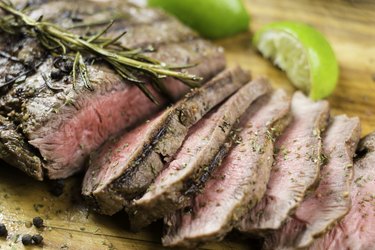
Whether you're trying to cut down on red meat or slim down your budget, thin steaks can be an attractive option. The goal is to keep all the tenderness and flavor of the beef so that your thinner portion is just as satisfying as fatter fare.
Thin and Thinner Steaks
Video of the Day
Even though some steak experts contend that big slabs of meat are the only way to go, thin steaks have their charms too. Some steaks are born thin, while others are sliced that way. Flank steak, skirt steak and rib-eye are relatively thin cuts, often an inch or less in thickness.
Video of the Day
Other thin "steaks" can be found plastic-wrapped in the meat section, sliced from larger cuts and marketed as sandwich, minute or shaved steak. Technically, they can be taken from any beef cut, though more often than not they're sliced from round steak. These minute steaks can be as thin as 1/8 of an inch.
How Do You Make Steak Tender?
If you want to keep your thin steak tender, first make sure you've done your due diligence before turning on the heat. You might tenderize the beef by pummeling it with a meat mallet or dunking it in marinade. A little attention before cooking can break down some of those tough, fibrous tissues often found in cheaper cuts.
At the same time, bear in mind that minute steaks are sliced thin in the first place in order to minimize connective tissues in the meat. Moderation, as usual, is the key. Don't soak a very thin steak in marinade for so long that it starts to get mushy. Usually 30 minutes or so is enough time for the marinade to work both to tenderize and to give the meat a little extra flavor.
How to Cook Thin Steak
Both overcooking and undercooking can result in tough, chewy meat. For the best texture and flavor, you'll want the meat to be browned on the outside but cooked on the inside just enough to reach the desired temperature (from about 125 degrees Fahrenheit for rare to 150F for well done). If you don't already have a meat thermometer in your kitchen, get one. They're inexpensive and invaluable for the home cook.
- You can bake an inch-thick steak in the oven at 400F. Rub the steak beforehand with a goodly amount of olive oil (together with seasonings if you like), which will help it to brown and keep it from drying out.
- Braise strips or slices of steak in a sauce that includes such tenderizing elements as tomato, vinegar, wine, citrus or yogurt. The sauce will do the same work a marinade would have done.
- To cook your steak for a stir fry, cut the meat into strips and cook them quickly in a wok first. Remove it while cooking the vegetables and then add it in again before serving.
- Cooking a thinner-than-average steak on the grill isn't out of the
question, but it should be at least 3/4-inch to 1-inch thick. It is recommended that you pat the steak dry and then rub it with a mixture of kosher
salt and cornstarch first and then put it in the freezer for about half an hour before
grilling it on the hot setting (for gas grills).
- The cornstarch/salt technique can also be used for steaks cooked in a cast-iron skillet. Using the mixture on a dry steak and freezing it for 30 minutes beforehand will give you a good sear without overcooking the meat.
- Old-fashioned "chicken frying" will also protect your steak from overcooking while giving it a delicious crust. This method involves first dredging a minute steak in a flour mixture, then in an egg mixture and one more time in flour before frying in hot oil. When the steak is done, place it on paper towels to drain and prepare white gravy with the pan drippings.
- If you want your thin-sliced steak just plain pan fried, cook it for 30 to 60 seconds in a very hot pan with a bit of oil. When that side is done, flip it over. This is a very quick process, so keep your eye on it.
What to Do Through Thick and Thin
Regardless of the technique you use, let your steak rest for a few minutes after removing it from the heat. If a steak is cut too soon, it will release too much juice, thereby losing some of its flavor also.
You don't want to keep flipping the meat over and over again while it's cooking in the skillet or on the grill. Usually, once is enough. Lift up the edge a bit to check the sear and use the stick thermometer for interior temperature. When one side reaches a good sear, then go ahead and flip it.
If the temperature isn't where you think it should be, turn down the heat a bit for the second side. Remember that the meat will continue to cook for a few minutes after it's removed from the heat.